By Dr. K. Javeed Nayeem
From Udaipur which was our base, a day long excursion took my family and me to the fortress town of Chittorgarh, about a hundred-and-twenty kilometres North-East of it. Chittor was once the capital of the Mewar rulers who after the advent of field artillery shifted their base to Udaipur which they felt was less vulnerable to attacks from invaders.
Not surprisingly, most people know Chittor more for the interesting story of its queen Padmini and less for its actual historic importance although all history books dismiss this story only as a figment of the fertile imagination of some unknown story teller from the past.
Spread over an area of nearly seven hundred acres, it rightfully claims the credit of being the largest fort in the country. Its claim of being the largest fort in Asia is disputed by the claim of the Ranikot Fort that is located in Pakistan. This is not surprising considering the fact that we share many other disputes too with Pakistan! But to put the record straight, let me tell you that the Ranikot Fort which is also known as the ‘Great Wall of Sindh’ is just a thirty-two kilometre long wall which does not enclose anything and which therefore does not seem to protect anything. Historical records are not clear about when it was built or by whom or for what purpose. The most sensible assumption that we can make is that it was perhaps built to demarcate two territories ruled by two different ruling dynasties.
The Chittorgarh Fort on the other hand is a fort built to protect the hilltop township of Chittor that lay within its precincts. It is indeed a formidable looking place with its massive ramparts being visible from a great distance as you approach it. The fort sits on a linear, flat-topped hill, overlooking the expanse of fertile lands that surround it.
Although this very historic place has always been a very popular tourist spot we were told that after the recent controversy spawned by the film Padmavat, the inflow of tourists has more than doubled. This is not very surprising as any controversy always draws people like bees to nectar. That is why perhaps film-makers these days always make it a point to first spark a controversy over some contentious issue whenever they start making a film. This move itself takes care of the publicity required to instantly convert the film from mediocre pulp to a box office hit !
We went to Chittorgarh hoping to savour a slice of the rich history of the place but came back utterly disappointed with the filmy ‘story’ that was forced upon us by the guides and the locals alike. We wanted to know about the many kings who built the fort and the many Palaces and temples within and how the huge complex was designed to resist invasion. But all that we were told by our exuberant guide was how their queen Padmini agreed to break the age-old traditions of the Rajputs and be seen by Allauddin Khilji to save her kingdom and how aghast her subjects were at this suggestion.
Then he went on to elaborate over how they hatched a plot to impersonate her with a substitute to hoodwink the invader into believing that he had seen the real Padmini and thus sparing their kingdom from plunder and ruin. Whenever I turned away a little to take a peek beyond the Palace walls or whenever I interrupted him to ask him what the interesting looking building in the distance was, he would be mortified that I was not interested in listening to the fascinating story that he was telling me. He would plead with me to first listen to the full story of their legendary queen before asking any questions about what we had set out to see. I could understand his frustration and disappointment because he was taking great pains to get us to understand how the fake queen stood behind a curtain and where the expectant Allauddin Khilji stood and the exact angle at which the mirror was placed in which he was supposed to see her reflection.
When he particularly emphasised how a safe distance separated them by pointing to the balconies of two different buildings that stood on the two banks of a large pond I could not help wondering whether Alladduin Khilji went there armed with a predecessor of the Nikon binoculars that I had around my own neck that day! I quickly realised that we were stuck with the wrong guide that day and our guide too realised that he was stuck with a completely wrong family for the day but there was nothing that we could do about it.
But on looking around we found that all the other guides who were taking groups of other tourists around the place were telling them the same story about Queen Padmini and Allauddin Khilji and nothing about Chittorgarh itself ! That left us with the consolation that hiring the man that we had hired was not a mistake after all but only an inevitable misfortune. We realised that we had come to Chittorgarh a couple of years too late when its importance had shifted from what it once was to what it now is — from being a place steeped in history to just an open-air theatre where the storyline of a Bollywood blockbuster is re-enacted for gawking audiences day after day !
e-mail: [email protected]








Every where in the world, the guides narrate the story of their place which has a connection to the movies. If one visits New Zealand, The vast expanse of places in the country is linked to the Lord of the Rings movie sites, and Chittorgarh narrative by the guides is not surprising. If one is interested in the history of the fort , one should read the history of it before hand, reading relevant books in a library. Many tourists get attracted to a place to know about the link to a movie, not necessarily purely because of its historical importance.
Please Google “Chittor fort” or see the link
https://www.chittorgarh.com/article/chittorgarh-history/231/
No point in merely delving into history, if concerned monuments, forts and palaces are not maintained, and preserved to highlight their historic significance.
The best time to visit these places was in mid-1950s , when one could enjoy forts, linking them to their history when neglect was not yet set in. These days, the values of Indians have changed in regards to appreciation of history, and this is reflected in the ways the guides present their narratives linking the forts and palaces to movies which most tourists want to hear.